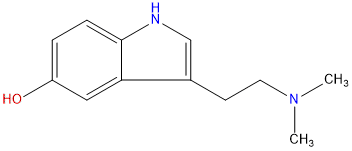
BufoteninCAS No.:487-93-4
|
||||||||||
 |
|
|
||||||||

| Catalogue No.: | BP4265 |
| Formula: | C12H16N2O |
| Mol Weight: | 204.273 |
Product name: Bufotenin
Synonym name: Dimethylserotonin; Mappin; Mappine; N,N-Dimethyl-5-hydroxytryptamine; N,N-Dimethylserotonin
Catalogue No.: BP4265
Cas No.: 487-93-4
Formula: C12H16N2O
Mol Weight: 204.273
Botanical Source: Bufonis Venenum
Type of Compound: Alkaloids
Purity: 95%~99%
Analysis Method: HPLC-DAD or/and HPLC-ELSD
Identification Method: Mass, NMR
Packing: Brown vial or HDPE plastic bottle
Storage: Store in a well closed container, protected from air and light. Put into refrigerate or freeze for long term storage.
The product could be supplied from milligrams to grams
Inquire for bulk scale.
For Reference Standard and R&D, Not for Human Use Directly.
Description:
Bufotenine may have hallucinogenic potential, the presence and levels of bufotenine might be useful and important markers of some psychiatric disorders. Bufotenine is able to block rabies virus infection in BHK-21 cells.
References:
J Psychoactive Drugs. 2000 Jul-Sep;32(3):321-31.
Bufotenine: toward an understanding of possible psychoactive mechanisms.
METHODS AND RESULTS:
A review of the neuropharmacology of the alleged hallucinogen Bufotenine is presented, including recent experimental results showing activity similar to LSD and other known hallucinogens (psilocin and 5-MeO-DMT) at the purported hallucinogenic serotonin (5-HT) receptors, 5-HT2A and 5-HT2C. In addition, current reports of computer modeling of the receptors and ligand binding sites give evidence of Bufotenine's ability to bind and activate these receptors. While binding and activation of the purported hallucinogenic receptors are not the full extent of the hallucinogenic signature, this evidence shows support for the rationale that the reported lack of the drug's classic hallucinogenic response in human experiments is due to poor ability to cross the blood brain barrier (BBB), not lack of activation of the appropriate brain receptors. Further evidence is reviewed that in some physiological states, some drugs with characteristics similar to Bufotenine which do not normally cross the BBB, cross it and enter the brain.
CONCLUSIONS:
While direct human experimental evidence of Bufotenine's hallucinogenic activity seems lacking, the above combined factors are considered, and possible explanations of Bufotenine's reported psychoactivity are suggested. Additionally, updated experimental models testing the possible nature of Bufotenine's hallucinogenic potential are proposed.
J Venom Anim Toxins Incl Trop Dis. 2014 Oct 13;20(1):45.
Bufotenine is able to block rabies virus infection in BHK-21 cells.
Rabies is a fatal zoonotic neglected disease that occurs in more than 150 countries, and kills more than 55.000 people every year. It is caused by an enveloped single stranded RNA virus that affects the central nervous system, through an infection initiated by the muscular nicotinic acetylcholine receptor, according to many authors. Alkaloids, such as acetylcholine, are widespread molecules in nature. They are present in numerous biological fluids, including the skin secretion of many amphibians, in which they act (together with proteins, peptides and steroids) as protection agents against predators and/or microorganisms. Among those amphibians that are rich in alkaloids, there is the genus Rhinella.
METHODS AND RESULTS:
Bufotenine was isolated from Rhinela jimi skin secretion after a liquid-liquid partition (H2O:CH2Cl2) and reversed phase high-performance liquid chromatography analyses (RP-HPLC). Bufoteninewas also extracted from seeds of Anadenanthera colubrina in acetone solution and purified by RP-HPLC, as well. Structural characterization was performed by mass spectrometry and nuclear magnetic resonance analyses. Cytotoxic tests of Bufotenine were performed over baby hamster kidney (BHK-21) cells using MTT test. For the antiviral activity, Rabies virus strain Pasteur vaccine (PV) was used on fluorescence inhibition test and fluorescent foci inhibition test, with both simultaneous and time course treatment of the cells with the virus and Bufotenine. In the present work we describe the effects of Bufotenine, obtained either from toads or plants, that can inhibit the penetration of rabies virus in mammalian cells through an apparent competitive mechanism by the nicotinic acetylcholine receptor. Moreover, this inhibition was dose- and time-dependent, pointing out to a specific mechanism of action.
CONCLUSIONS:
This work do not present or propose Bufotenine as a drug for the treatment of rabies due to the hallucinogen and psychotropic effects of the molecule. However, continued studies in the elucidation of the antiviral mechanism of this molecule, may lead to the choice or development of a tryptamine analogue presenting potential clinical use.
Neuroreport. 1995 Nov 27;6(17):2378-80.
Bufotenine reconsidered as a diagnostic indicator of psychiatric disorders.
We have analyzed products of the serotonin-degradative pathway, in which both N-methylserotonin and Bufotenine are formed in urine specimens of products with psychiatric disorders by three-dimensional HPLC with electrochemical detection.
METHODS AND RESULTS:
Bufotenine was detected in urine from all autistic patients with mental retardation and epilepsy (n = 18) and many autistic patients (32/47) with mental retardation. Bufotenine was detected in the urine of 15 of 18 patients with depression. Thirteen of 15 schizophrenic patients were also positive for Bufotenine. N-methylserotonin was also detected in some cases of each disorder. Only two of 200 urine specimens from healthy controls were positive for Bufotenine.
CONCLUSIONS:
Thus, the presence and levels of Bufotenine might be useful and important markers of some psychiatric disorders.